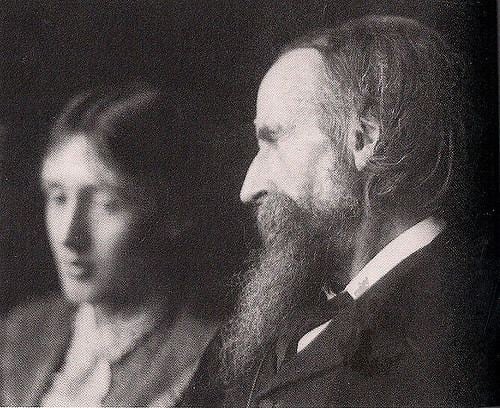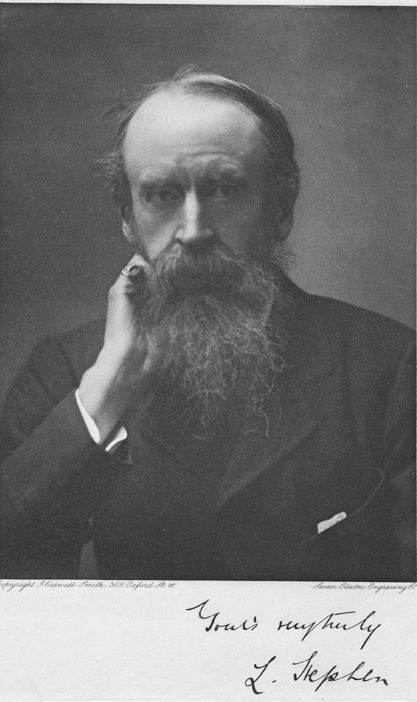Nationality English Parents James Stephen Role Author | Name Leslie Stephen Period Victorian era | |
 | ||
Children Virginia Woolf, Vanessa Bell Books Hours In A Library (4 Volumes), playground of Europe, The English Utilitarians, An agnostic's apology, Sir Leslie Stephen's Mausoleu Similar People | ||
Leslie Stephen
Sir Leslie Stephen (28 November 1832 – 22 February 1904) was an English author, critic, historian, biographer, and mountaineer, and father of Virginia Woolf and Vanessa Bell.
Contents
- Leslie Stephen
- Life
- 1 Harriet Minny Thackeray 18671875
- 2 Julia Duckworth 18781895
- Career
- Mountaineering
- Works
- Death
- References

Life

Stephen was born at Kensington Gore in London, and son of Sir James Stephen and (Lady) Jane Catherine (née Venn) Stephen. His father was Colonial Undersecretary of State and a noted abolitionist. He was the fourth of five children, his siblings including James Fitzjames Stephen (1829–1894) and Caroline Emilia Stephen (1834–1909).

His family had belonged to the Clapham Sect, the early 19th century group of mainly evangelical Christian social reformers. At his father's house he saw a good deal of the Macaulays, James Spedding, Sir Henry Taylor and Nassau Senior. After studying at Eton College, King's College London and Trinity Hall, Cambridge, where he graduated B.A. (20th wrangler) in 1854 and M.A. in 1857, Stephen remained for several years a fellow and tutor of his college. He recounted some of his experiences in a chapter in his Life of Fawcett as well as in some less formal Sketches from Cambridge: By a Don (1865). These sketches were reprinted from the Pall Mall Gazette, to the proprietor of which, George Murray Smith, he had been introduced by his brother.
(1) Harriet (Minny) Thackeray 1867–1875

The family connections included that of William Makepeace Thackeray. His brother, Fitzjames had been a friend of Thackeray's and assisted in the disposition of his estate when he died in 1863. His sister Caroline met Thackeray's daughters, Anny (1837–1919) and Minny (Harriet Marian Thackeray 1840–1875) when they were mutual guests of Julia Margaret Cameron (of whom, see later). This led to an invitation to visit from Leslie Stephen's mother, Lady Stephen, where the sisters met him. They also met at George Murray Smith's house at Hampstead. Minny and Leslie became engaged on December 4, 1866 and married on June 19, 1867. After the wedding they travelled to the Swiss Alps and northern Italy, and on return to England lived at the Thackeray sister's home at 16 Onslow Gardens with Anny, who was a novelist. In the spring of 1868 Minny miscarried but recovered sufficiently for the couple to tour the eastern United States. Minny miscarried again in 1869, but became pregnant again in 1870 and on December 7 gave birth to their daughter, Laura Makepeace Stephen (1870–1945). Laura was premature, weighing three pounds. In March 1873 Thackeray and the Stephens moved to 8 Southwell Gardens. The couple travelled extensively, and by 1875 Minny was pregnant again, but this time was in poor health. On November 27 she developed convulsions, and died the following day of eclampsia.
After Minny's death, Leslie Stephen continued to live with Anny, but they moved to 11 Hyde Park gate South in 1876, next door to her widowed friend and collaborator, Julia Duckworth. Leslie Stephen and his daughter were also cared for by his sister, the writer Caroline Emelia Stephen, although Leslie described her as "Silly Milly" and her books as "little works". Meanwhile, Anny was falling in love with her younger cousin Richmond Ritchie, to Leslie Stephen's consternation. Ritchie became a constant visitor and they became engaged in May 1877, and were married on August 2. At the same time Leslie Stephen was seeing more and more of Julia Duckworth.
(2) Julia Duckworth 1878–1895
His second marriage was to Julia Prinsep Duckworth (née Jackson, 1846–1895). Julia had been born in India and after returning to England she became a model for Pre-Raphaelite painters such as Edward Burne-Jones. In 1867 she had married Herbert Duckworth (1833 − 1870) by whom she had three children prior to his death in 1870.
Leslie Stephen and Julia Duckworth were married on March 26, 1878. They had four children:
In May 1895, Julia died of influenza, leaving her husband with four young children aged 11 to 15 (her children by her first marriage being adult by then).
Career
In the 1850s, Stephen and his brother James Fitzjames Stephen were invited by Frederick Denison Maurice to lecture at The Working Men's College. Leslie Stephen became a member of the College's governing College Corporation.
Stephen was an Honorary Fellow of Trinity Hall, Cambridge, and received the honorary degree Doctor of Letters (D. Litt.) from the University of Cambridge and from the University of Oxford (November 1901). While at Cambridge, Stephen became an Anglican clergyman. In 1865, having renounced his religious beliefs, and after a visit to the United States two years earlier, where he had formed lasting friendships with Oliver Wendell Holmes, Jr., James Russell Lowell and Charles Eliot Norton, he settled in London and became a journalist, eventually editing the Cornhill Magazine in 1871 where R. L. Stevenson, Thomas Hardy, W. E. Norris, Henry James, and James Payn figured among his contributors.
In his spare time, he participated in athletics and mountaineering. He also contributed to the Saturday Review, Fraser, Macmillan, the Fortnightly, and other periodicals. He was already known as a climber, as a contributor to Peaks, Passes and Glaciers (1862), and as one of the earliest presidents of the Alpine Club, when, in 1871, in commemoration of his own first ascents in the Alps, he published The Playground of Europe, which immediately became a mountaineering classic, drawing—together with Whymper's Scrambles Amongst the Alps—successive generations of its readers to the Alps.
During the eleven years of his editorship, in addition to three volumes of critical studies, he made two valuable contributions to philosophical history and theory. The first was The History of English Thought in the Eighteenth Century (1876 and 1881). This work was generally recognised as an important addition to philosophical literature and led immediately to Stephen's election at the Athenaeum Club in 1877. The second was The Science of Ethics (1882). It was extensively adopted as a textbook on the subject and made him the best-known proponent of evolutionary ethics in late-nineteenth-century Britain. He was elected a member of the American Antiquarian Society in 1901.
Stephen also served as the first editor (1885–91) of the Dictionary of National Biography.
Mountaineering
Stephen was one of the most prominent figures in the golden age of alpinism (the period between Wills's ascent of the Wetterhorn in 1854 and Whymper's ascent of the Matterhorn in 1865) during which many major alpine peaks saw their first ascents. Joining the Alpine Club in 1857 (the year of its formation), Stephen made the first ascent, usually in the company of his favourite Swiss guide Melchior Anderegg, of the following peaks:
He was President of the Alpine Club from 1865–68.
Works
Death
He died in Kensington. He is buried in the eastern section of Highgate Cemetery in the raised section alongside the northern path. His daughter, Virginia Woolf, was badly affected by his death and she was cared for by his sister, Caroline. Woolf in 1922 created a detailed psychological portrait of him in the fictional character of Mr. Ramsay in her classic novel, To the Lighthouse, (as well as of her mother as Mrs. Ramsay). (Ref: The Diaries and Letters of Virginia Woolf)
For Family Trees of the Stephens, Thackerays and Jacksons, see Bicknell (1996) and Bloom and Maynard (1994).
